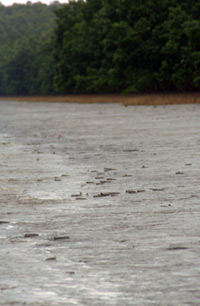Common names:
Italy |
Italian |
boleoftalmo punteggiato* |
England |
English |
white-spotted mudskipper* |
Papua New Guinea |
Wapi language (Purutu Island, Fly River Delta) |
poti |
* proposed name
|
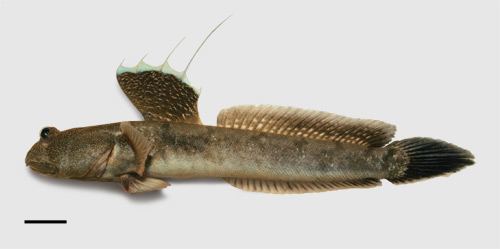
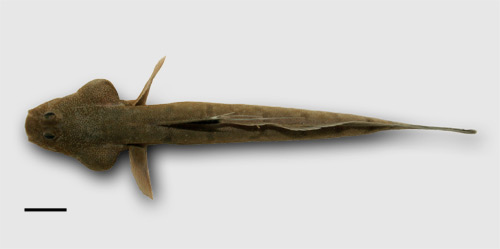
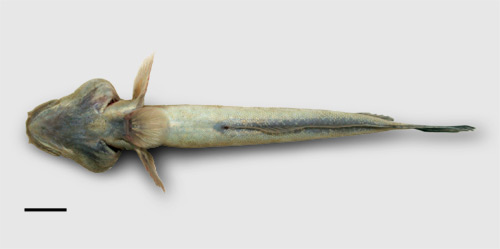
Boleophthalmus poti. USNM 40566, paratype, Sisikura Island, Fly River delta, Papua New Guinea;
lateral view (above); dorsal view (centre); ventral view (below);
the bar is 10 mm long - freshly dead male (photo: G. Polgar, 2007)
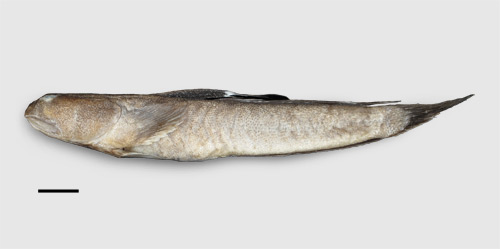
Boleophthalmus poti. MSNG 56891, holotype, Sisikura Island, Fly River delta, Papua New Guinea;
lateral view; female, specimen preserved in 70% ethanol (photo: G. Polgar, 2007)
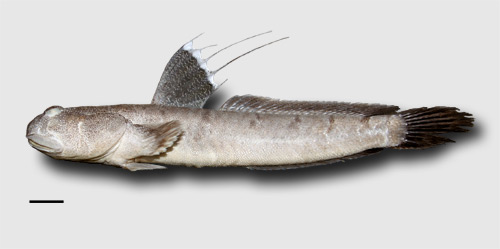
Boleophthalmus poti. BMNH 2011.1.27.1, paratype, Sisikura Island, Fly River delta, Papua New Guinea;
lateral view; female, specimen preserved in 70% ethanol (photo: G. Polgar, 2007)
|
|
Synonyms:
Etymology:
'Boleophthalmus' depicts the capability of these fishes to rapidly raise their eyes above the level of their orbits, as if they were
ejected out of their orbits: from 'bolê' (ejected), and 'ophthalmôn' (eye) (
Cuvier & Valenciénnes, 1837)
The scientific name derives from its common name, in the language of the indigenous people of the Wapi villages of Purutu Island (Fly River delta,
Papua New Guinea), where the type material was collected (Polgar et al., 2013)
|
Maximum recorded length:
106 mm SL (Polgar et al., 2013)
Live colouration (Polgar et al., 2013):
background colouration of dorsolateral portion of body and head yellowish-brown to greyish; ventral portion greyish and paler; in some
individuals, isthmus, throat and thoracic region dark grey; scattered tiny whitish speckles covering head, extending anteriorly and dorsally from
snout to insertion of D1; 8–10 subvertical, saddle-like, bilaterally asymmetrical and irregular dark brown bars on dorsum (2–3 before D1, 2 in front
and behind D1, and 4–5 below D2), saddle-like bars never extending below lateral midline; one horizontal, darker, irregular brownish band 1/3 width
of body depth may be present on sides above lateral midline and below saddlelike bars, coursing from pectoral fins to caudal peduncle;
sparse whitish speckles present on flanks; several scales on caudal peduncle with whitish margins. Caudal fin with grey interradial membranes and
black rays. Anal fin with blackish rays and darkened inter-radial membrane, posterior portion more densely pigmented. Pectoral fins with translucent
interradial membranes and pale brown rays, muscular base with similar colouration to body. Pelvic fins with translucent interradial membranes
and pale brown rays, proximally dark grey, both dorsally and ventrally
Colouration on preservation (Polgar et al., 2013):
body colouration dorsally and
laterally greyish, ventrally paler; isthmus, throat
and thoracic regions grey, dark grey in some individuals.
Small white speckles and vertical dark bars visible in
preservation; on fins, live brown colour becoming grey
and yellow whitish; live whitish pigmentation remains in
preservation; other traits as in vivo
Diagnosis (Polgar et al., 2013):
Boleophthalmus poti is similar to B. birdsongi and B. caeruleomaculatus, sharing with these species unnotched,
flattened and horizontally disposed dentary teeth.
It is distinguished from these species (and all
congeners) by having elongate D1 fin spines protruding
from the fin margin, in both sexes and the following unique
features of dorsal-fin colouration in live individuals: D1
with clearly demarcated sky-blue to whitish marginal band;
interradial membranes of D1 greenish-brown, spotted with
whitish to yellowish speckles, sometimes fused into broken,
narrow and wavy lines; interradial membranes of D2 grey
to pale brown, darker posteriorly, pale grey distally, with a
very thin white margin and columns of 0–5 whitish spots
between adjacent rays; D2 rays darker than interradial
membranes
Diet:
undescribed. However, all of Boleophthalmus species exhibit almost identical feeding behaviours and probably have similar diets
(e.g., see B. boddarti)
Reproduction:
the details of its life cycle have not been described in literature, but are probably similar to those of congeneric species
(see Reproductive behaviour and
B. pectinirostris)
|
|
Ecological notes:
locally abundant along the marine fringe and in front of the pneumatophore zone of mangrove forests (Polgar et al., 2010);
the adults dig burrows on the muddy banks of creeks, of river mouths, and on higher mudflats, usually not too far from the first row of trees
(Polgar et al., 2010).
During low tide, B. poti shows ecological partition between larger individuals, found on unvegetated tidal mud and near the water's edge, and smaller individuals, on the forest floor and in the pneumatophore zone (Polgar et al., 2010); a similar pattern was observed in different habitats of the same ecosystem in Boleophthalmus boddarti (Polgar & Bartolino, 2010), B. birdsongi (Takita et al., 2011), Periophthalmus gracilis, Oxuderces dentatus, while an apparently inverse pattern was observed in P. variabilis (Polgar & Bartolino, 2010)
left: B. poti individuals were found near the water's edge, on the sloped banks of the Wapi Creek, Purutu Island, Fly River delta, Papua New Guinea (photo: G. Polgar, 2007)
right: aggregation of B. poti along the water's edge, on a mudflat at several metres from the pneumatophore zone; Sisikura Island, Fly River delta, Papua New Guinea (photo: G. Polgar, 2007)
|
|
|
|
|
Distribution:
presently only known from the delta of the Fly River, in the Gulf of Papua
(Polgar et al., 2010; 2013)
|
Remarks:
freshly dead individuals of B. poti less than 5 cm SL (see photo A) have a transparent, indistinct margin of D1, a much less densely pigmented D2 with columns of brownish spots on a
transparent background, hyaline pelvic fins, scattered dark brown spots on the head and flanks on the anterior third of the body, and some irregular brown blotches on flanks,
roughly corresponding to the dorsal saddle-like bands observed in larger specimens.
Boleophthalmus poti
differs from B. birdsongi in having fewer interdorsal scale rows (3–6 vs. 6–9,
respectively; Polgar et al., 2013), a longer D1 base (13–15% SL vs. 10–13% SL,
respectively; Murdy, 1989;
Polgar et al., 2013), and in the colouration of the unpaired fins: in the latter species, D1 is proximally black and distally blue; D2 has a narrow whitish basal
portion, proximally and medially black, and a yellowish to whitish marginal band.
Boleophthalmus poti differs from B. caeruleomaculatus in the smaller number of
lateral-scale rows (97–119 vs. 130–151, respectively), a shorter D2 base (40–43% SL vs. 43–48% SL, respectively) and a shorter pelvic disc
(11–12%SL vs. 16–18%SL, respectively; Murdy, 1989; Polgar et al., 2013), in body colouration, which in the
latter species includes sky-blue speckles on head, dorsum and flanks, and sky blue skin of the eyes' dermal cups, and in the colouration of the unpaired fins:
B. caeruleomaculatus lacks distinct marginal bands and has sky-blue spots on the
interradial membranes, arranged in series along the whole length of rays. Boleophthalmus caeruleomaculatus also attains a larger size than the other two species
(maximum recorded size = 165 mm, vs. 111 mm and 106 mm of B. birdsongi and B. poti,
respectively; Murdy, 1989; Takita
et al., 2011; Polgar et al., 2013), and exhibits sexual dimorphism in the D1: females have elongated spines III–V, the IV being the longest one (Polgar et al., 2013).
Boleophthalmus poti is traditionally consumed and used as bait in the delta of the Fly River, together with the other mudskipper species
B. caeruleomaculatus and
Periophthalmodon freycineti Quoy & Gaimard (Polgar & Lim, 2011). |
Photographs of Boleophthalmus poti:
|
A: young of B. poti (photo: G. Polgar, Purutu Island, Fly River delta, Papua New Guinea,
2007); B: a close-up (photo: G. Polgar, Wapi Creek, Purutu Island, 2007); C:
two individuals inside a tank (photo: G. Polgar,
2007); D: A typical catch by Wapi fishermen on a mudflat in front of a mangrove forest. Bsp:
Boleophthalmus sp.; fre: Periophthalmodon freycineti; Ss: Scilla sp. Notice how the crabs are tied up
with grasses, to be safely transported. (photo: G. Polgar, Sisikura, Fly River delta,
2007)
|
Drawings of Boleophthalmus poti:
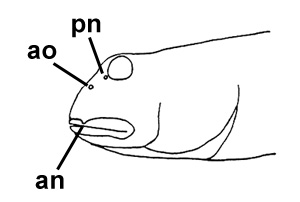
A |
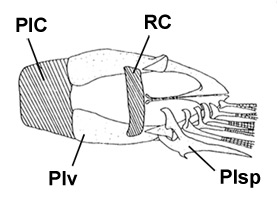
B |
A: cephalic sensory and nasal pores of Boleophthalmus spp.: an = anterior nostril; ao = anterior oculoscapular canal pore;
pn = posterior nostril (modified from Murdy, 1989)*;
F: ventral view of the pelvis of B. boddarti (pelvic fin elements removed from left side: modified from
Murdy, 1989): PIC = pelvic intercleithral
cartilage; Plv = pelvis; RC = rectangular cartilage; Plsp = pelvic fin spine* - * with permission
|









